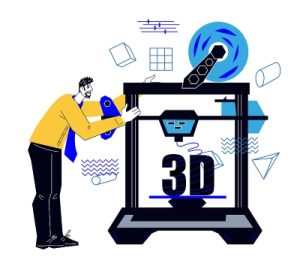
While most people are familiar with 3D printing as something your engineer neighbor messes around with in their basement to produce small models, the applications of the technology can be much more significant than a hobbyist's weekend activity. The technology is being used in some mission critical and massive scale projects across government.
Construction
An early, small-scale application of 3D printing in the construction industry was recreating historical fixtures for renovations. Historical buildings, many of which house government agencies and government-run museums, have light fixtures, molding, door knobs, etc. that may need replacing. Finding actual replacements for centuries old materials is incredibly difficult and building them from traditional materials is time consuming and costly. 3D printing has proven to be a valuable solution to maintaining the historical look quickly and at a much reduced cost. Continue reading


 Agility has been a key attribute for success over the past year and a half. Everyone had to quickly adapt in their personal and professional lives to do things in new ways to keep business and society running. Even the great bureaucracy of government found itself pivoting and quickly changing "how it's always been done" to meet the needs of the day. This should not end with the return to what feels like pre-pandemic normal. In the form of Agile methodology, Agility will play a huge role in the government's ability to continue the fast-forwarded digital push as a result of the pandemic.
Agility has been a key attribute for success over the past year and a half. Everyone had to quickly adapt in their personal and professional lives to do things in new ways to keep business and society running. Even the great bureaucracy of government found itself pivoting and quickly changing "how it's always been done" to meet the needs of the day. This should not end with the return to what feels like pre-pandemic normal. In the form of Agile methodology, Agility will play a huge role in the government's ability to continue the fast-forwarded digital push as a result of the pandemic. With so many high-profile hacks this year, it's easy to want to throw up your hands and say, "Is there nothing that can be trusted?!" Interestingly, that lament is what is driving the latest approach to cybersecurity -- zero trust. Zero trust is what it sounds like, a security approach
With so many high-profile hacks this year, it's easy to want to throw up your hands and say, "Is there nothing that can be trusted?!" Interestingly, that lament is what is driving the latest approach to cybersecurity -- zero trust. Zero trust is what it sounds like, a security approach  FirstNet is a nationwide wireless broadband network for first responders being built and deployed through a first of its kind public-private partnership. FirstNet was borne out of the September 11, 2001 tragedy where it became clear that the radio systems police, fire, and paramedics relied on did
FirstNet is a nationwide wireless broadband network for first responders being built and deployed through a first of its kind public-private partnership. FirstNet was borne out of the September 11, 2001 tragedy where it became clear that the radio systems police, fire, and paramedics relied on did Natural Language Processing (NLP) is a computer science practice that aims to give computers the ability to understand
Natural Language Processing (NLP) is a computer science practice that aims to give computers the ability to understand 
